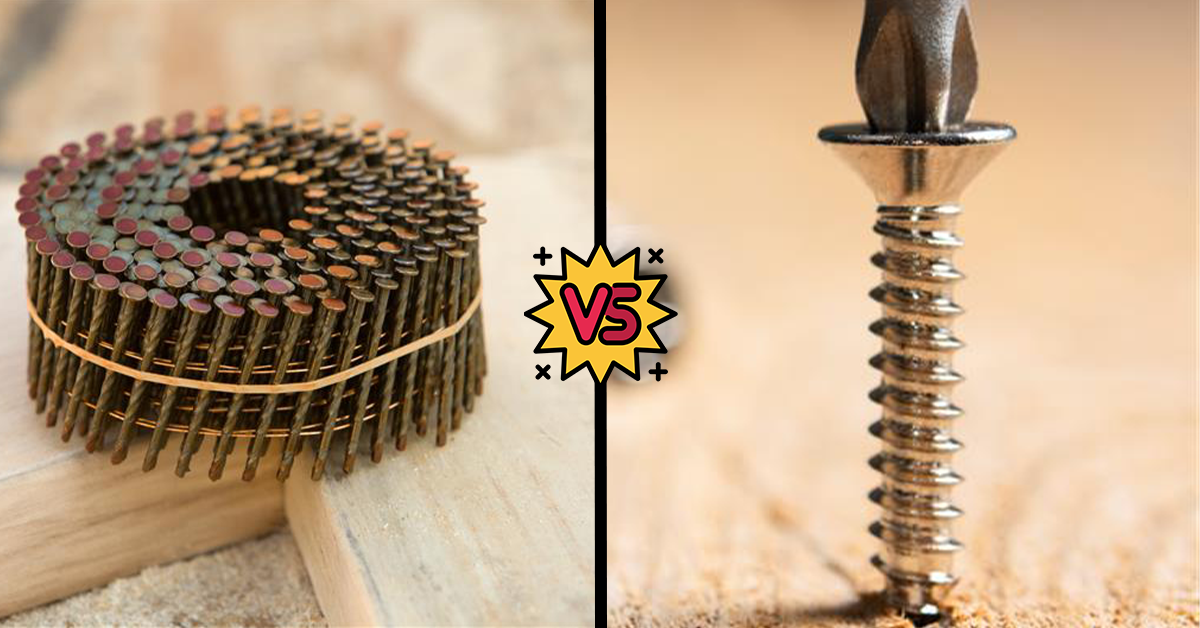Fasteners are an integral part of what holds together your wood packaging while it faces the turbulence of transportation. Pallets and crates are dependent on choosing the correct fastener types for the job. Not falling apart under stress is a main priority. When product protection is on the line, the right fastener types hold it together.
Nails versus screws is an age-old debate of which of the fastener types is superior. There are different opinions on which is the strongest and best for holding together packaging. In this article, we will discuss the history of these fastener types, how they are used, how they hold up under stress, and the benefits of working with a design team.
Fastener Types: A Quick History
Nails and screws have been around for hundreds of years with each being invented for different purposes and uses. These fastener types were not seen as rivals in the beginning though. This is mostly because screws were not as readily available as nails were.
The history of nails dates to around 3,400 BC when bronze nails were used in Ancient Egypt. They had the same shape and design that nails today have and were used for similar purposes. Eventually, nails started to be made with iron and the job of the “Nailer” was created. Nailers were skilled professionals that handmade each of these fastener types.
During the American Revolution, there was a severe nail shortage because England stopped supplying nails to the Americas. In turn, settlers would burn down old houses and buildings just to recover the nails. In 1795, a man named Jacob Perkins invented the cut-nail process, which involves cutting nails from sheets of the raw iron. This allowed nails to be produced quickly and efficiently for the first time.
The history of screws is similar but does not go as far back as nails. Screws were invented in the 15th century to fasten parts of early firearms to the wooden handle. People would hand-file the threads onto the screw. This was a long and laborious process, so they were not as common as nails. In 1760, two English brothers invented the first machinery to make screws. Slowly, screws would become more available to the public like similar fastener types.
Overview of Nails
Most nails on the market today are steel wire nails. These are made by drawing coils through multiple dies until they are at the diameter needed. Modern nails have become easy to make with the advancement in machinery. They are widely used when choosing between fastener types in the wood packaging industry. They are applied using a pneumatic nail gun, which makes building pallets and crates more efficient and much quicker.
Here at Conner Industries, we generally use two different types of nails for our wood packaging. There is the screw shank nail and the ring shank nail. The screw shank nail is a nail with a helical twist down the shaft and it has a higher withdrawal resistance than a staple. The ring shank nail has annular rings down the shaft and has a superior withdrawal resistance than the ring shank nail. Both nails can be applied with a nail gun, so they have comparable application times to other gun driven fastener types.
Overview of Screws
Screws are also heavily used in the wood packaging industry today. The screw’s threaded body allows it to grip material better than other fastener types. Because of this, they are known as the superior choice for joining wood products together. Additionally, screws are known for being easier to remove from wood materials. You simply unscrew it, and it leaves the wood product undamaged.
Conner uses different sized screws for different purposes depending on what is best for each individual product packaging. Screws are used when materials need to be held together and flexibility is not needed. The downside to screws is that they are time-consuming to use and more expensive than other fastener types. They have the highest withdrawal resistance but are more prone to snapping when weight shifts horizontally.
The Stress Factor
Nails, screws, and other fastener types can withstand different types of stress, which is why it is best to research (or work with a design team) to find what would be best for your specific product.
Nails have more shear strength. This means that they can withstand more lateral, or side-to-side, pressures. The saying “bend don’t break” comes to mind when speaking of nails. They are not likely to snap and are able to bend with excessive pressure. Therefore, nails are generally best when weight could move side to side during transportation or loading/unloading.
Screws have more tensile strength. This refers to the screw’s ability to withstand the pressures that pull apart materials. The thread holds onto the material and makes it harder for it to separate from the wood. As stated above, screws do not have much flexibility or shear strength, making them more prone to snapping.
Size Matters
After choosing between fastener types, the next step is to figure out what size is going to be optimal for your wood packaging. Generally, 1.5 inches is the optimal insertion of fasteners into the wood. This gives it the best connective strength without damaging the wood. There are instances when this cannot be achieved because of how thick the wood is, in which case choosing the fastener with the best fit without protruding through the other side is best.
The size of the nails and screws will determine the strength of the pallets and crates. It is essential to make it the longest it can be while taking into account countersinking. The fastener that is pneumatically driven will not usually be flushed with the wood; it often sits slightly below the surface. Your measurements must consider this to avoid fasteners protruding from the packaging.
Importance of Design Teams
Deciding between fastener types is just one of many steps in the wood packaging process. There is more than meets the eye when it comes to pallets and crates.
Working with a design team will provide an in-depth look into what wood packaging is the best for your product, its method of transportation, and your overall manufacturing processes. You may be able to decrease the number of materials used while keeping strength and protection, which will lower costs. Design teams make your life easier and save you money.
Nails vs. Screws: Who is the Winner?
The truth of the matter is that when working with wood packaging you are going to be using both nails and screws. These fastener types are an integral part of the industrial packaging industry, and they are not going anywhere. They both have benefits for different types of projects, so both come out as winners.
Working with a trustworthy supplier can help you to improve your current manufacturing process or help you design something new. At Conner, we have trained technicians, knowledgeable sales staff, subject matter experts, a design team, and engineers all committed to providing the best solutions possible for your unique challenges. Using the proper fastener types on your packaging might not be your top priority, but it is an essential part of maintaining the longevity, durability, and strength of your wood packaging.




![[PRESS RELEASE] Conner Industries Announces Major Guardian Packaging Expansion](https://conner.b-cdn.net/wp-content/uploads/2024/10/Guardian-Packaging-Expansion-500x383.jpg)
![[PRESS RELEASE] Conner Industries Announces Website Dedicated to Integrated Packaging Division](https://conner.b-cdn.net/wp-content/uploads/2024/05/Conner-Packaging-Blog-500x383.jpg)


